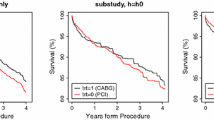Abstract
In clinical and epidemiologic studies of time to event, the treatment effect is often of direct interest, and the treatment effect is not constant over time. In this paper, the authors propose an estimator for the cumulative hazard difference under a stratified additive hazards model. The asymptotic properties of the resulting estimator are established, and the finite-sample properties are examined through simulation studies. An application to a liver cirrhosis data set from the Copenhagen Study Group for Liver Diseases is provided.
Similar content being viewed by others
References
Kaplan E L and Meier P, Nonparametric estimation from incomplete observations, Journal of the American Statistical Association, 1958, 53(282): 457–481.
Cox D R, Regression models and life tables, Journal of the Royal Statistical Society, 1972, 34(2): 187–202.
Dabrowska D M, Doksum K A, and Song J K, Graphical comparison of cumulative hazards for two populations, Biometrika, 1989, 76(4): 763–773.
Kalbfleisch J D and Prentice R L, Estimation of the average hazard ratio, Biometrika, 1981, 68(1): 105–112.
Parzen M I, Wei L J, and Ying Z, Simultaneous confidence intervals for the difference of the two survival functions, Scandinavian Journal of Statistics, 1997, 24(3): 309–314.
Song Y and Prentice R L, Estimation of the 2-sample hazard ratio function using a semiparametric model, Biostatistics, 2011, 12(2): 354–368.
Schaubel D E and Wei G H, Double inverse-weighted estimation of cumulative treatment effects under nonproportional hazards and dependent censoring, Biometrics, 2011, 67(1): 29–38.
Tang X Y and Wahed A S, Cumulative hazard ratio estimation for treatment regimes in sequentially randomized clinical trials, Statistics in Biosciences, 2015, 7(1): 1–18.
Li C X, Two-sample tests for survival data from observational studies, Lifetime Data Analysis, 2018, 24(3): 509–531.
Wei G H and Schaubel D E, Estimating cumulative treatment effects in the presence of nonproportional hazards, Biometrics, 2008, 64(3): 724–732.
Dong B and Matthews D E, Empirical likelihood for cumulative hazard ratio estimation with covariate adjustment, Biometrics, 2012, 68(2): 408–418.
Zhang M and Schaubel D E, Estimating differences in restricted mean lifetime using observational data subject to dependent censoring, Biometrics, 2011, 67(3): 740–749.
Wang X and Schaubel D E, Modeling restricted mean survival time under general censoring mechanisms, Lifetime Data Analysis, 2018, 24(1): 176–199.
Huang B and Kuan P F, Comparison of the restricted mean survival time with the hazard ratio in superiority trials with a time-to-event end point, Pharmaceutical Statistics, 2018, 17(3): 202–213.
Tian L, Fu H, Ruberg S J, et al., Efficiency of two sample tests via the restricted mean survival time for analyzing event time observations, Biometrics, 2018, 74(2): 694–702.
McKeague I W and Sasieni P D, A partly parametric additive risk model, Biometrika, 1994, 81(3): 501–514.
Lin D Y and Ying Z L, Semiparametric analysis of the additive risk model, Biometrika, 1994, 81(1): 61–71.
Kang F Y, Sun L Q, and Cheng X M, An additive hazards model for clustered recurrent gap times, Journal of Systems Science & Complexity, 2018, 31(5): 1377–1390.
Schlichting P, Christensen E, Andersen P K, et al., Prognostic factors in cirrhosis identified by Cox’s regression model, Hepatology, 2010, 3(6): 889–895.
Martinussen T and Scheike T H, A semiparametric additive regression model for longitudinal data, Biometrika, 1999, 86(3): 691–702.
Hernán M A, Brumback B, and Robins J M, Marginal structural models to estimate the joint causal effect of nonrandomized treatments, Journal of the American Statistical Association, 2001, 96(454): 440–448.
Pollard D, Empirical Processes: Theory and Applications, NSF-CBMS Regional Conference Series in Probability and Statistics, Institute of Mathematical Statistics and the American Statistical Association, 1990.
Van der Vaart A W and Wellner J A, Weak Convergence and Empirical Processes, Springer, New York, 1996.
Author information
Authors and Affiliations
Corresponding author
Additional information
This paper was partly supported by the National Natural Science Foundation of China under Grant Nos. 11671268, 11771431 and 11690015, the Key Laboratory of RCSDS, CAS under Grant No. 2008DP173182.
This paper was recommended for publication by Editor LI Qizhai.
Rights and permissions
About this article
Cite this article
Lü, X., Zhang, B. & Sun, L. Estimating Cumulative Treatment Effect Under an Additive Hazards Model. J Syst Sci Complex 34, 724–734 (2021). https://doi.org/10.1007/s11424-020-0067-z
Received:
Revised:
Published:
Issue Date:
DOI: https://doi.org/10.1007/s11424-020-0067-z




